
Psychotherapy Book Reviews
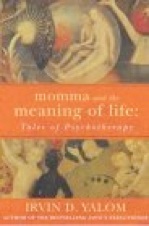
By Irvin Yalom (Piatkus Books)
£7.99 Pbk June 2000
ISBN 074992103X
Some time ago a paper was presented at a large psychological conference in America intriguingly entitled "Professors' office door decorations: what do they tell?" One wonders at the cryptic meanings to be read from the various brass, plastic, glass and wooden runes on professorial doors scattered across the land. Beyond door decorations, and into the seemingly mysterious world of human relations behind the therapy door, we are fortunate to have the doubly gifted storyteller and psychotherapist Irvin Yalom to let us in. His new book Momma and the Meaning of Life is a second collection of therapy tales which, I am glad to say, carry the same spellbinding quality, grasp and erudition as his first collection contained in Love's Executioner.
For readers unfamiliar to Yalom, the pleasure of his writing is his darned ability to pluck sparkling insights from the darkest of places. Add to that a genius for telling stories and you are a little closer to understanding why this man's writing is so compelling. In Momma Yalom reveals more about himself than any of his other books. His mother and a dream are the start of a trail that criss-crosses his life.
What about momma? What was she like? Yalom draws a picture of an ill tempered, overpowering and vain woman with whom he never remembers sharing "a warm moment." But she's not all-bad. Yalom shares a moment of them together; a moment when she is enjoying her son's books. Unable to read them because of a sight problem, she handles then tenderly and says, "Big books. Beautiful books." The rational son, on the other hand, points out that it is what is in the books that is important not how they feel. "Oyvin, don't talk narishkeit-foolishness. Beautiful books!" This motherly sense and presence is something that returns in different shapes to all the six tales within the book. The tales are: 'Momma and the Meaning of Life'; 'Travels with Paula'; 'Southern Comfort'; 'Seven Advanced Lessons in the Therapy of Grief; 'Double Exposure'; and 'The Hungarian Cat Curse'. All the tales have elements, in varying degrees, of non-fiction. Some like 'Southern Comfort' (my favourite), a story concerning a remarkable black woman in inpatient psychotherapy, are pure non- fiction "flecked only with fiction to conceal the patients' identity." But, as the author also says, "not only does fiction have its own truth, but every story, no matter how true, is a lie because it omits so much."
Yalom is both a storyteller and teacher. His 'academic' books succeed, having sold in thousands and having been translated into some twenty languages, because they impart knowledge through stories. These stories engage us regardless of whether or not we are health professionals because the only qualification we need is that we are human. Hence he has sold 700,000 copies of a book that looks more like a building block than a book (need I say one of his 'Big books'-Group Psychotherapy) and has charted novels and tales into best-seller lists about, of all things, existential psychotherapy. As a therapist of dialogue, he has done a great justice to psychotherapy and the notion of "healing through meeting."
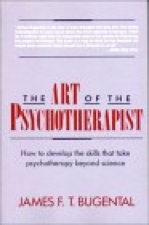
The Art of the Psychotherapist
By James Bugental (W.W.Norton)
$12.95 September 1992
ISBN 0393309118
As a therapist 'out there', after my training, I know that my learning is ongoing. Supervision, workshops, colleagues, patients and books are all sources of this learning. Some books are like old friends that I keep turning back to. The Art of the Psychotherapist by James Bugental is one of these.
Published in 1992, and writing it in his seventies, Dr Bugental was drawing from a well of some half a century's worth of psychotherapy experience. He writes in the preface "writing this book is a culminating effort for me. I have been invested in trying to find ways of communicating what hundreds of patients have taught me about how we humans frame our being, how we express our questing, and how we-wittingly and unwittingly-defeat some of our best efforts." This giant task of processing, distilling and writing it all down, is a wish to "aid therapists, of different orientations, who intend doing depth, life-changing work to extend the range and power of their own perspectives."
To understand the book better, some words need to be said about "depth psychotherapy." Depth psychotherapy, as the author explains, values subjective experience as primary for examining and changing the way we have answered the big questions of life, the existential questions of life. Questions such as, "How do I live?", "Who am I?" and "What do I want from my life?" On the objective-subjective psychotherapy range of working, this is different from the also valuable objective endeavours of aiming and reducing symptoms. Time is another distinguishing factor. In an increasingly speedy world, depth psychotherapy requires not a paddock of five sessions but open land-twice weekly meetings and years.
The challenge, which I believe the author has met, is laying down some routes into working with subjectivity while at the same time preserving it. Like a rain forest rich with experience, it wouldn't be quite the same from an air con coach with piped musak. As well as providing compasses, maps and vehicles, the author shares his experiences as a psychotherapist on a journey. His honesty is rewarding. He shares some frank lessons. For example, he reflects on the folly of a time when he was too involved in taking care of his patients. The example is echoed in a recent interview with Victor Yalom (published on www.psychotherapy.net) when he said, "just yielding to the neediness of the client is not therapy." The lure of engendering positive transference.
Of all the chapters in the book, I particularly enjoyed the one about 'Intentionality and Spiritedness'. For me it is the engine of the book and crucial to my understanding of depth therapy. I did wonder why though it came so late in the book. The chapter describes the 'Jacob's ladder' like ascent of impulses from the unconscious (our intentionality), up the steps of wish, want and will to their actualisation, or not, in the world. The death of impulses along the way makes me think of a witty remark said by a colleague to me about a certain place where we worked: "This place" he said, "is like a water butt in which the kittens of possibility are drowned." So it is with our wishes.
In sum, the book is wise, imaginative and practical. Copious clinical examples of patient and therapist dialogue aid this communication. There's even an appendix with suggestions and exercises to develop the principles within the book. Someone, I forget where, described it as a "gem of a book." I agree and I hope that in an ever busy and competitive world The Art of the Psychotherapist is a spirit that will never be drowned.
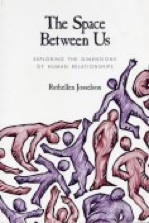
The Space Between Us: Exploring the Dimensions of Human Relationships
By Ruthellen Josselson (Sage)
£15.99 Pbk January 1992
ISBN 0761901264
From the first paragraph I read, in one of the volumes of The Narrative Study of Lives, I liked Ruthellen Josselson. Not only did she write well, she had spirit. Her contribution to the book begins with a description of a time when she took part in a psychologcial experiment. Her task was to respond to descriptive test statements with stories. She dragged herself out into a cold dark snowy night, to a lecture hall where she met the pages of test statements, statements like, "at the end of the first year, Anne, is at the top of her medical school class." Matching her stories to her mood, she wrote florid, bizarre stories in the styles of famous novelists. Years later she discovered the experiment was to test "fear of success." The test had more relevance to crazed creative writing skills than fear of success which, by the way, was actually a big issue in her life then. I mention all of this by way of introducing the author to you and to say that Josselson's interest in the study of human beings is not through quantitative methods but through human experience.
The Space Between Us is a book about the development of a language to describe the ways that people relate to each other. Given the importance of human relationships to our well-being, the author recognises that science leaves us wanting when patients ask questions like, "But what can I expect from my husband?," "Am I being greedy?" and "Am I expecting too much?" As she puts it, her book aims, "to draw a tentative map of the roads that connect people so we can think more sharply about them and understand better what we need from others and what others need from us." Integrating phenomenology, people's experiences, with "what our best thinkers have said about relationships" (primarily psychoanalytic object relations and self psychology thinkers) she lays out her map over "eight dimensions of relatedness" with their pathological poles e.g. the "holding" dimension in absence is "falling" and in excess "suffocation." Each chapter explores a dimension with theory and then with people's true life accounts, gleaned from interviews with the author. Outside of the 'dimension chapters' there are two additional chapters one on 'Sex Differences in Relatedness' and 'Notes on Love'.
The Space Between Us is not a how-to-do-therapy book. It is a resource and a statement about our need for relationships in the "web of connections to others" in which we "know and realize ourselves only in, through and with others." But, she points out, relatedness relies on separateness so whether, as psychotherapists, we conceive of ourselves as 'separatists' (locating problems in faulty separation-individuation) or 'connectionists' (problems with making human bonds) we're still talking about the same story, as the self goes through life separating and connecting. Space is a bold and articulate book formed from intelligent thinking and real experience. On the subject it deserves to be a key text.
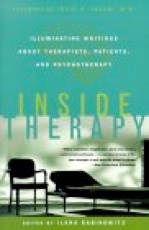
Inside Therapy: Illuminating Writings about Therapists, Patients, and Psychotherapy
Edited by Ilana Rabinwitz, Foreword by Irvin Yalom (St. Martins Press)
$13.95 Pbk May 2000
ISBN 0312263422
"To be or not to be" is a question relevant to this collection of writings about psychotherapy. In different ways they are all variously about how therapists are being, or not being, with their patients. Iliana Rabinowitz's collection includes excerpts from novels, case histories, short stories and academic texts from the 1940s to 1990s, though the bias of these texts is towards psychoanalysis. The book as whole, as I see it, is about two issues in psychotherapy: the mechanism of therapeutic listening and the therapist's presence in the relationship. Lest to say there is much else in this stimulating book.
Irvin Yalom's way of working, his foreword and writings in the book underline the importance of presence which in turn holds true to psychotherapy's fundamental axiom that it is the relationship between therapist and patient that is key to people healing in psychotherapy-a relationship that is genuine and creative. While listening and presence require each other, a therapist can be listening with heart, mind and soul and not be present in the relationship. Classical psychoanalytic theory emphasises a discipline of therapeutic silence and anonymity. In contrast, a therapist could be self-revealing with a patient. One hundred years on from the invention of the 'talking cure', this idea of transparency strikes fear into the heart of many therapists. Yalom writes, "whenever I lecture to a professional audience on the subject, I immediately sense an autonomic discharge sweeping through the audience: perspiration, enlarged pupils, furtive glances at the nearest exits." Inside Therapy however, suggests that therapeutic listening and presence actually complement each other. The hidden therapist can benefit their patient by saying more while the talkative active therapist can benefit their patient by listening and sitting back more.
Rabinowitz champions listening with her selection of texts about the subject. They include Listening with the 'Third Ear', 'Freud's Invention', 'Bare Attention' and 'Who Listens?' This kind of special listening, 'an evenly suspended attention,' underlines the need for therapists to be sensitive and aware of themselves and their patients. Mark Epstein in 'Bare Attention' finds parallels with Freud's ideas and a Buddhist approach to psychotherapy. Both perspectives of listening require impartiality, non judgement and openness. The latter is perhaps the link to presence, the other aspect of the book particularly brought out by Yalom. In being open, the therapist opens up the possibilities of the relationship. While the therapist has to put down the security blanket of categories, diagnoses and therapeutic procedures, and probably feel anxious, chances are both patient and therapist will come alive.
Yalom's and Fromm's writings are more positively about therapist 'presence'-therapist commitment, transparency, authenticity and engagement. These qualities put therapists like Yalom fairly and squarely in a genuine relationship with the people he meets, patients like Elva for example. The account of Elva's therapy in I never thought it would happen to me ends with a fine example of this kind of relationship as Yalom enquires about the contents of Elva's large hand bag. There follows a wonderful lightness of leg-pulling and squabbling as Yalom and Elva disgorge the improbable and fantastic contents, item by item. This brings me back to the piece 'Listening with the Third Ear' (now out of print) written by psychoanalyst Theodore Reik in the 1940s. He writes, "the devil himself could not frighten many analysts more than the use of the word 'I'." Reik wrote this about psychoanalytic literature but the same is also true about the therapeutic hour. The book, in its collective form, is an opportunity to listen to the ebbs and flows of a number of therapists Ts'-how they are with patients, what happens when they do things differently, when things go 'wrong,' when they listen to their intuition and so on. The variety of therapists included in the book provide quite a comparison and this was one aspect I really liked about the book. Amongst the various contributors are existentialists, Freudians, psychiatrists, psychologists and a Buddhist psychotherapist. Rabinowitz's book I think will have most appeal to psychotherapists. I do hope others read it though because the book helps to make the mechanics and nature of psychotherapy more transparent-a service that the profession could well benefit from. There's a lot to Inside Therapy. I highly recommended it as a source of inspiration and illumination.
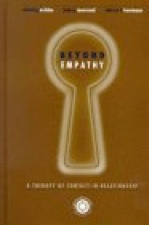
Beyond Empathy: A Therapy of Contact-In-Relationship
By Richard G. Erskine, Janet P. Mousand & Rebecca L.Trautmann (Brunner/Mazel)
£27.95 Hbk August 1999
ISBN 0876309635
Did you ever watch Northern Exposure on television? The series focused on Joel, a New York doctor who, following his training, is obliged to work in Alaska. Needless to say he is not happy. In one episode he reluctantly counsels a patient after a cursory reading of Carl Rogers. Patient-"I've been feeling unhappy." Joel-"You've been feeling unhappy." Patient-"Yes." Joel-"Yes"... a few exchanges later. Patient-"Are you all right Joel, you seem to be repeating everything I say?" Joel did his best to understand Carl Rogers but was as empathic as an Alaskan moose. Struggling through the series, his powers of 'mooseness' always got him into trouble. He would have been left behind by Beyond Empathy. This book sets out a form of integrative therapy from therapies that had yet to be developed when Rogers was writing. Gestalt therapy, transactional analysis, psychoanalytic self psychology and British object relations theory are all rolled into Beyond Therapy. An unfamiliar book to me, I review it from the point of view of a psychotherapist not trained in this particular discipline. As something of an outsider, but as therapist valuing the therapeutic relationship, I wonder how useful this book would be to me and to others?
Often using colourful metaphors to convey meaning. Beyond Empathy is written in a friendly conversational style. The book starts well by conveying the power of human relationships on the self. It is the force that shapes the self and the force within integrative therapy that brings about change through the therapeutic relationship. "Self- the human self-is a product of relationship, relationship that is part of the infant's environment from birth," the book quotes. These words introduce the influence of the psychoanalyst Daniel Stern to the book. Stern's ideas about attunement show, as well as those on infant development (e.g. that infants differentiate themselves almost from birth and then progress through increasingly complex modes of relatedness throughout their lives-see "connectionists" in the next review). The book sets out other "Basic Concepts" including the goal of integrative therapy which is, "to dissolve the client's fixed gestalten-those fused-together patterns of thinking and feeling and behaving-so that the original components can be brought to awareness: with awareness comes the possibility of re-establishing contact with self and others (including the therapist), of replacing the old, automatic beliefs and behaviors and disavowals and distortions and of dealing with current experiences spontaneously and flexibly."
The theory of integrative therapy takes up the first half of the book. It is organised into three aspects of the therapist's behaviour "Inquiry," "Attunement" and "Involvement." Inquiry is the exploration aspect that intends to help clients discover the ways in which they have interrupted their contact with the themselves and the world. As so many therapies, including integrative therapy, have discovered though, intellectual understanding is not enough. Beyond Therapy underlines the importance of process over content here, the journey rather than the destination. While describing the purpose and characteristics of inquiry, this chapter also offers an "Inquiry Menu"-a list of things it might be therapeutically useful to inquire about. I was surprised there was no mention of dreams here but, I suppose, it could fall within one of the categories like "memories."
The next aspect dealt with is "Attunement"-the need for attunement, kinds of attunement (including developmental attunement), conveying attunement and other tasks. Though similar to mirroring and empathy, attunement is different because it involves the personal response of the hearer as well as the intent of the hearer. This "personal response" or therapeutic "presence" was an issue brought out in Inside Therapy, reviewed earlier. Here the stance on therapist presence is much clearer. Without therapist, presence there can be no real interpersonal relationship between therapist and patient, and no real therapy. With attunement then, and the overlapping aspect involvement, integrative therapy really distinguishes itself from classical psychoanalysis which emphasised the therapist being a "blank screen" and interpreting.
Issues like presence, openness, acknowledgement, normalisation and interest are tackled within "Involvement." It is an interesting chapter, written wisely and with experience. I say this with some relief because delving into the artistry of how a therapist should 'be' with a patient is potentially fraught and usually hidden-much easier to write about technique. Involvement doesn't stop with this chapter though. The theme carries over into the next chapter with the patient's "Relational Needs." Beyond Therapy identifies eight human relational needs, such as "valuing". These needs allude to integrative therapy's influence from self psychology and Kohut's identification of 'selfobject transferences'. Yet there seems to be a difference in the approaches. Kohut advised that these needs should not be satisfied by the therapist (if they were satisfied, the client wouldn't then seek healthy selfobject satisfaction outside therapy). Beyond Therapy, on the other hand, counsels an appropriate response that seems, at least sometimes, to satisfy these needs. I say 'seems' because I found the book a bit vague here. At times the therapeutic intention was to satisfy relational needs, at others the intention was to bring them to awareness so the client could experience split off parts of the self. I needed some overall clarification before the details of each of the relational needs. With this reservation, I found this section of the book thought provoking and fascinating. It is useful to have some pegs, so to speak, in the complexity of the therapeutic relationship. Assuring as they may be, I was happy that Beyond Therapy went back over itself and 'loosened' the pegs up. Therapy is never that orderly and pegs can damage a genuine therapeutic relationship.
The next chapter brought the whole show together with a complex "Keyhole" diagram showing the facets of integrative therapy and taking the reader through phases of therapy. But here I've only taken you up to only half of this 380 page book, but the greater part of this review. The reason? The first half of the book is the heart of the book. The second half moves from theory to theory-into-practice with extended transcripts of therapy sessions. Broken up with descriptions and explanations, the transcripts hang theory on real work and were much appreciated. Finally the book revisits "the keyhole" in an attempt to tie the therapy up with a model and facets of therapeutic intervention. Frankly I wasn't able to really take this all in-a reflection partly on the complexity and also on a reader new to integrative therapy.
Returning to my original question, I can say most definitely that I found Beyond Therapy useful and very informative. Netting quite a haul of theory, a reading of this book will leave you with quite a catch. For readers new to the approach this may be a challenge to digest-for even familiar theory takes on a different spin within the approach. I liked the apparent clinical experience, words that could be used, words that somehow carried a certain authority and experience beyond the rest. Overall I liked the book's human feel that carried over into the value and care of the therapeutic relationship. A credit to the book that in presenting so much information and theory it succeeded in leaving the therapeutic-relationship in tact. A thoughtful and careful book that should appeal to training, and more experienced, therapists.
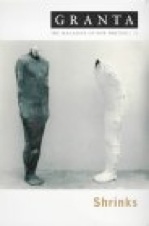
Shrinks: Granta 71
Edited by Jack
(Granta) £8.99 Pbk October 2000
ISBN 0903141388
Granta have stretched the meaning of shrink with this edition of Shrinks. But then Granta calls itself a magazine when to me it really is a book and found on a book case-it has a decent sized spine, it isn't going to be recycled on a Sunday after washing the car, nor is it likely to be found beside a toilet or amongst the towel-soap-disinfectant-magazine debris of a bathroom floor. But all of this non-magazine identity goes to the wall because Granta is a periodical. I concede. But why does an account of the summiting of Mont Blanc count as writing in some way relevant to the world of psychiatry, psychoanalysis or therapy in its broadest sense? Well Shrinks, I am reminded by the back cover, is devoted to "the kinks and twists of the human mind, and their treatments." Ahh I see it now-mountain therapy, of course. Fergus Flemming's contribution is from his new book Killing Dragons. He reminds us that like the seas mountains have their monsters too. This perhaps is a better reason for the inclusion of Flemming's contribution. There opens a rich vein of literature as to the whys and wherefores of people climbing large rock forms in great adversity. Flemming's jolly piece, on the other hand, explains how psychologically out of reach these high places were. Certainly these climbers had hopeless kit, by modem standards, but it was the psychological block that was actually the key to anyone climbing mountains. Flemming illustrates the fear of these places when he describes how travellers of old were carried blindfold over places like the Alps "lest they be overwhelmed by the awfulness of the scenery."
Awfulness of a different order emerges from Edmund White's autobiographical piece called 'Shrinks'. Quackery and a belief that being a homosexual is something needing a cure mark the lonely formative years of White's life. If only his other therapists had been as generous as the psychiatrist who first diagnosed him as being 'unsalvageable' and left him alone. Dr. Moloney, however, believed he could help. And Moloney, it seems, needed to prove that he could help White, not for , , , . White's sake but Once we clear away the psychic his own. So as underbrush all that will wither Moloney's chaotic away..."- he made my homosexuality life crumbled sound like the fate of the state in the amidst his bird Marxist future." cages and Papuan deities he needed Edmund White more proof, more clients to cure. At a time when he was seeing some 50 patients a week he commits his most selfish act towards White. He persuades White not to go away to Harvard. Perhaps time? Perhaps even therapy? White writes about this time with a certain wry humour. He remembers for example about Moloney saying about his homosexuality 'Once we clear away the psychic underbrush all that will wither away.' "He made my homosexuality sound like the fate of the state in the Marxist future," he writes. White's was the outstanding contribution to this Granta.
The other eight contributions include a short piece by Paul Auster which Jungians will see as the work of synchronicity. A clever piece of fiction by Elliot Perlman, a barrister, whose 'The Emotions Are Not Skilled Workers' puts the reader in the uncomfortable position of being the perpetrator. lan Parker revisits the infamous experiments set up by Stanley Milgram in the 1960s. You'll remember the experiment when I say this was the man who revealed the terrible willingness of ordinary American's to torture other American's with the 'electric box.' The experiments like its creator are not as straightforward as they seem. Journalist Judith Herman writes a mesmeric story about an old, red coral bracelet whose life washes over generations to a therapist's consulting room. Ruth Picardie's face I remember from the Observer's magazine and the column she wrote called Life as she was dying of cancer. Three years later her sister is writing here about trying to come to terms her sister's death. A strong and cynical woman it is telling that she looks at so many options for relief, including the spirit world.
There are three more pieces in Granta but I haven't read the extra and non-shrinks related piece by Roy Hattersley-In Search of the Third Way. This leaves Amit Chaudhuri and Tim Parks. Chaudhuri takes us to India and the awkwardness of a funeral ceremony. I was surprised about the evident awkwardness because I perceive India as being more at ease with death. Clearly though there's difficulties with people who kill themselves, as this woman had. The "don't talk about the deceased," it seems is taken to a different and more conspicuous level. It reminded me too of the importance and prevalence of soft drinks like Fanta, Gold Spot and Coca-Cola at ceremonies like this across South-east Asia. The last piece of writing to mention is by the novelist and travel writer Tim Parks. Married to an Italian woman, his brother-in-law Paolo is diagnosed with paranoid schizophrenia. He is the subject of Park's writing. While Paolo's illness is managed by drugs, sometimes more, sometimes less. Park's observes the currents of Paolo's relationships with acuity. The disinterest in the significance of these relationships, particularly between Paolo and his mother, leads Parks to a somewhat disingenuous conclusion of where we may all be if we rely only on drugs. My second favourite contribution. Finally there's a photographic contribution of Antony Gormley's sculpted 'bodies', photographed by Gautier Deblonde. The cover photo is particularly arresting as one body, headless and bound, struggles to communicate to the other. One might think it is a modem day parody of a shrink and their patient like those cartoons in the New Yorker of old. But we've moved on from those remote, speechless, sleeping Shrinks haven't we.